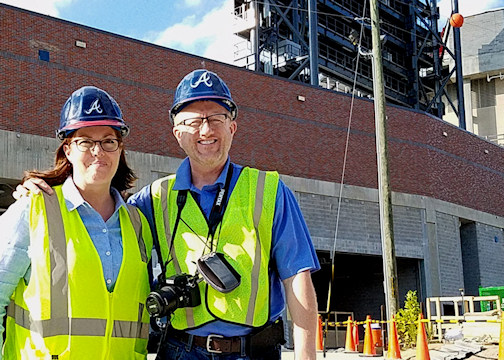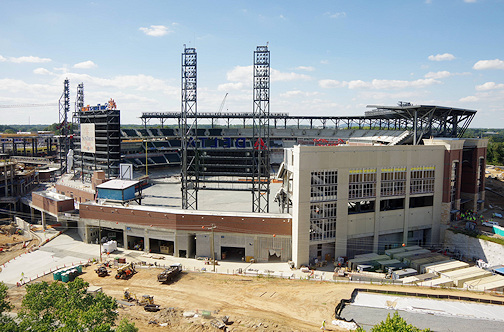While in Atlanta for the final two baseball games at Turner Field (see our photo essay on it here), the Braves graciously agreed to take me on a tour of the construction site for SunTrust Park, which will become their home in 2017. This article and the accompanying photos lets you know what I saw and learned.
Leading the tour was Derek Schiller, President of the Braves’ business operations. Also along was Beth Marshall, Senior Director of Public Relations. The insight provided by the two of them was simply outstanding, because you need to understand the reasons behind the team’s desire for a new facility to appreciate its location and why it was designed the way it was.
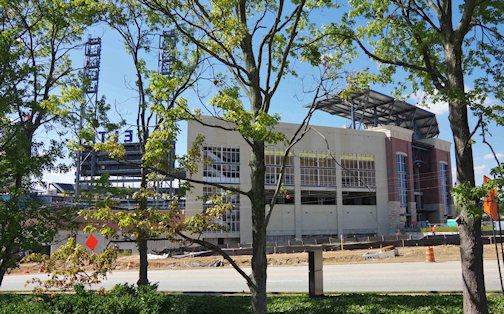
In case you’re not familiar with the new park’s location, it’s a dandy. It’s quite close to the interchange of two of the area’s major highways, I-75 and I-285, in Cobb County, about ten miles north of Atlanta’s downtown.
Prior to the Braves’ acquisition of the parcels of land to make this project possible, this was an oblong piece of largely undeveloped land bounded by Windy Ridge Parkway on the north and Circle 75 Parkway on the east and south. Even though it’s very much in the center of an enormous amount of traffic, it hadn’t been developed partly because major pipelines ran beneath the property. On the south side of Circle 75, though, were several office buildings. The Braves set up a “Preview Center” in one of them. The photo above looks across Circle 75 from the front of that office building. Three years ago, this same scene showed thick trees and a pond.
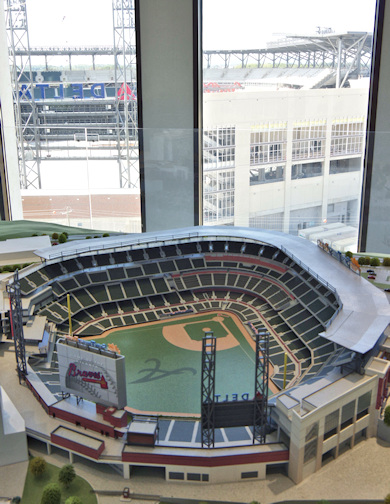
Through the windows in the Preview Center, you have an excellent view of the ballpark’s construction. So visitors can see what the finished project will look like, there is a scale model.
The suite in the office building is useful to host prospective corporate sponsors and potential luxury-suite buyers — and the occasional journalist like me. Here, with the emerging ballpark as a backdrop, visitors can be told about the Braves’ vision of a ballpark with adjacent commercial development. “One of the things we had as a prerequisite was really redefining what the fan experience means,” Schiller explained. “It’s really going back to the old-school way of fan experience. Baseball stadiums grew out of neighborhoods, so they were as much about the neighborhood experience as about the ballparks themselves.” He mentioned Fenway and Wrigley as prime examples of this.
He points out in recent decades, sports teams lost sight of that. “When you gave your ticket at the gates, that was where the fan experience began for that venue.” The Braves want to change that, because they figured that fans’ opinion of the experience of attending a ballgame is “made up of what they did before the game as well as what they do after the game.” That’s where the concept of having multiple entertainment options in a mixed-use development came in.
The team originally hoped to do this on the land surrounding Turner Field (see our interview with team exec John Schuerholz for more about that). When it became apparent that the Braves weren’t going to be given the opportunity to purchase the land needed to pull this off, they started looking elsewhere. Here in Cobb County is where they decided to build a new ballpark and adjacent development that is called The Battery Atlanta.
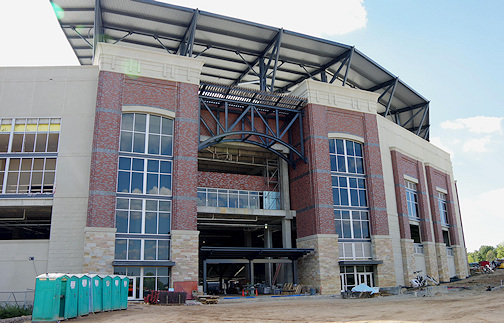
Populous is the architecture firm designing the stadium. Schiller noted that in the past, “when fans walk up to one of their ballparks, they (Populous) want it to look like it is very substantial. They want you to walk up to it and say, ‘Oh my gosh! This is a big building!’ We had the exact opposite challenge (for Populous) here, because we didn’t want this big building to make the mixed-use development look disjointed, so a lot of what we spent time on was minimizing the feel and sizing and the scaling of the building.
“To help with the scale, we used a pre-cast stone. It looks custom hand-laid,” he explained. “It’s at all of the entryways. It brings the whole scale of the brick way down,” making the exterior of the ballpark look far less imposing when compared to the buildings in The Battery Atlanta. You can see the interaction of the stone and brick in the entryway above, which is near the left-field foul pole.
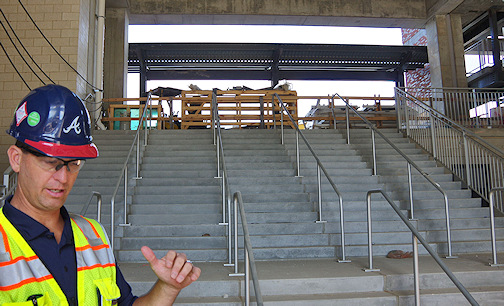
According to Brad Albers, the lead project architect for SunTrust Park from Populous, “The site was challenging because there was a lot of topography. From the high point to the low point on the (ballpark) end of the site, there’s about 70 or 80 feet.”
Schiller said the Braves and Populous decided to look at this as an opportunity rather than a deal-breaker. “Instead of trying to push all that dirt around and make it level, we embraced that and took advantage of that. So now when you arrive at the first-base or third-base entrances, you enter at grade. You then walk down to the main concourse (where Schiller is standing in the photo above), and further down to the seating. It’s dramatic.”
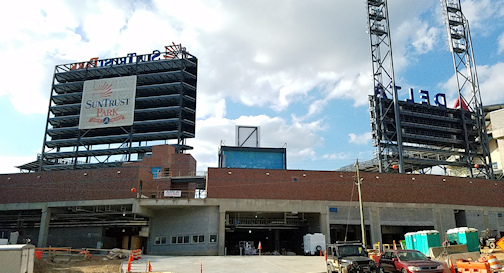
Albers added that it made sense for the access for trucks and heavy equipment to be at the lower end of the site’s uneven terrain. Hence, the opening on the ground level of the park is behind left-center field, shown above. This way, trucks can pull into the area from Circle 75 Parkway.
Also, the open area between the street and the footprint of the stadium acts as an “easement” where no buildings can be constructed. That’s because pipelines (that previously made the entire parcel challenging to develop) were re-routed before construction could begin, and underneath this ground is where those pipelines now run.
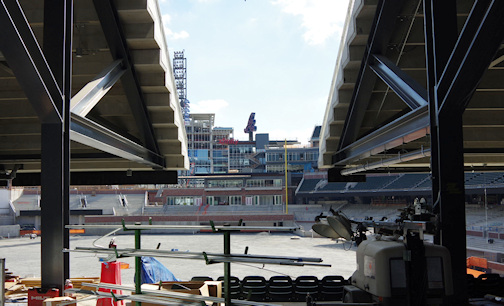
The shots above and below are of essentially the same spot. Schiller pointed out that there are two of these “notches” in SunTrust Park, where there is a break in the seating bowl. These help prevent the overall structure from seeming large and imposing.

The steel supports under the seating sections point out another important aspect of reducing the scale of the ballpark. The Braves decided to “take advantage of some engineering accomplishments, not the least of which is (a) cantilevered design, which brings all the seats closer to the field,” Schiller pointed out.

As you would imagine, SunTrust Park will offer well-heeled fans some truly impressive amenities. One is spacious luxury suites. The view above is from one of them roughly behind the home on-deck circle.
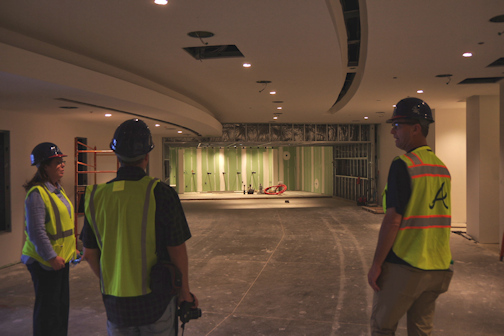
Behind the row of luxury suites is a mammoth club area. It is so large that it actually comprises several “neighborhoods” within the space, such as an all-inclusive food-serving area, a pub-like bar spot and a wine bar — complete with individual wine “lockers” for patrons to use.
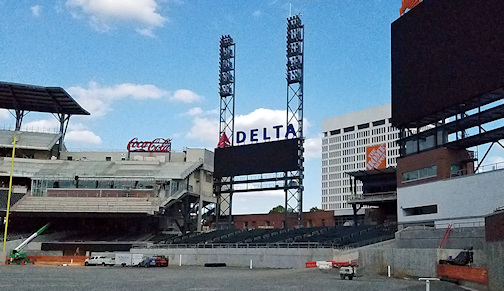
This shot was taken from the field-level seats down the first-base line, looking toward left field. Here you can see signs for three major corporate sponsors that are all headquartered in Atlanta. Note the Home Depot sign in center field.
When I asked Albers to name the ballpark features that he thinks are unique to SunTrust Park, he immediately said “The Home Depot Clubhouse Suite, because it’s a separate structure. We started with a concept of a tree house because of the sponsorship (from Home Depot). It’s a dedicated space in a separate structure, and I don’t know anyone else who has a suite like that.” Can’t wait to see the vantage point from it during a game.
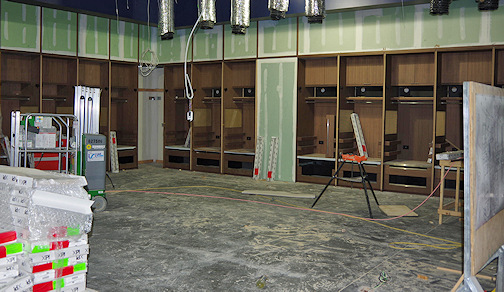
Well below ground is the Braves clubhouse, which is on the first-base side, just like at Turner Field. Yes, it will be quite a bit larger than their home clubhouse for the past 20 seasons.

Nearby are the workout and trainers’ areas. Of special interest to the players, no doubt, is the hydrotherapy room, shown here. Any time a new ballpark is built or renovated, quite a bit of money goes into the latest and greatest in hydrotherapy equipment.
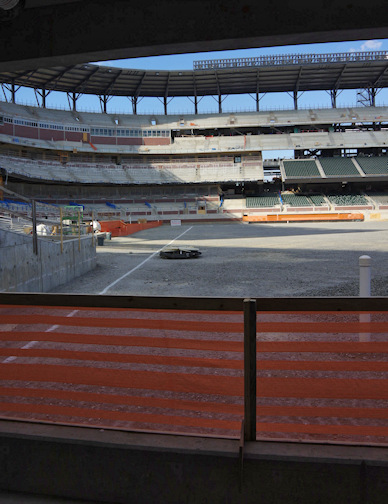
If you’ve attended a game at Turner Field, you undoubtedly noticed the extremely popular Chop House area in right field. Well, not only will SunTrust Park have its own Chop House, it will operate on three levels. Shown above is the view from its ground level, looking down the first-base line.
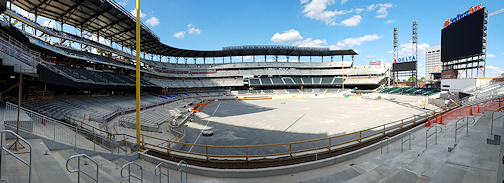
Here’s a panoramic shot of the view from the Chop House’s main level. You can see the bright-yellow foul pole on the left side of the photo. This also gives you a good look at the huge canopy over the upper deck. The Braves say that not only is it the largest in baseball, it will ensure 60% of the seats will be in the shade.
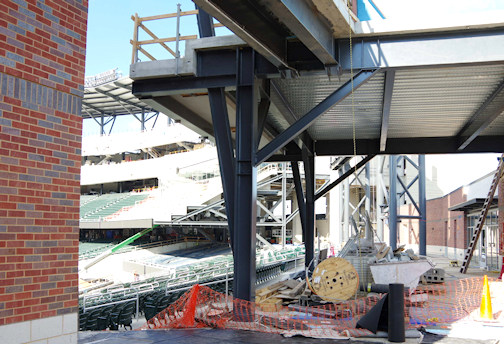
This photo was taken from below the scoreboard in center field. The elevated platform will house the aforementioned Home Depot Clubhouse Suite. Note that it is accessed from a walkway high above the concourse.
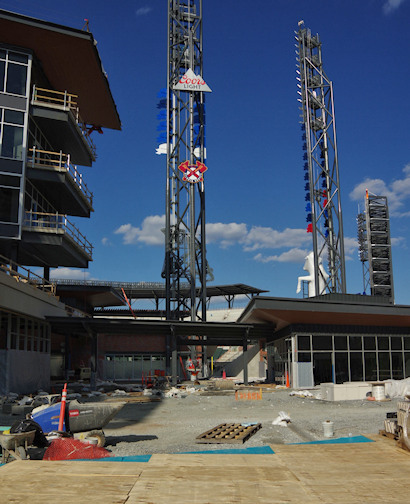
We’re now outside of the ballpark, beyond the Chop House looking back toward the seating bowl in the area known as The Plaza. “We probably spent more time on this than anything else,” said Schiller. During the early planning, the Braves brought the designers from Populous together with Wakefield Beasley, the local firm that oversaw the architecture of The Battery Atlanta, with the goal of having “the architecture of the ballpark embrace the mixed-use development,” where the west side of the ballpark “really opens up and grabs hold of and really works closely with it. The meeting point is The Plaza.”

Schiller added that The Plaza “can be activated for game days in very unique ways, and non-game days can be just as active.”

He added that “on the development side, there’s lots of little angles and porches and a lot of canopies and trellises that not only create shade, they also warm the architecture and give it a different scale.” Note the overhead walkway that will take fans directly from spots in The Battery to the upper level of The Chop House.

In this shot, you’re in the very center of the plaza, looking at what will be a covered, elevated stage for pre- and post-game entertainment — much like The Ballpark Village just outside of Busch Stadium in downtown St. Louis. The building under construction beyond that will be the Omni Hotel.
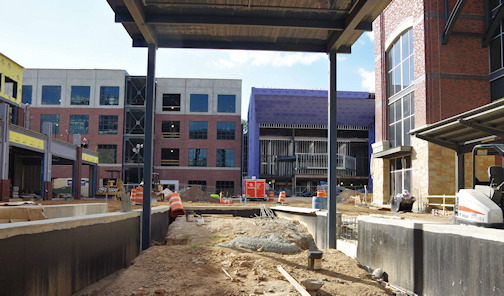
Looking the opposite direction, you see what will be the Coca-Cola Roxy Theatre in the background on the right (where concert promoters Live Nation will book musical acts), and office space on the left. The covered area in the foreground will house the set of the pre- and post-game shows for TV.

This view shows the ballpark on the left and the Omni on the right. The high-rise office building in the distance is where the Braves’ Preview Center is located.
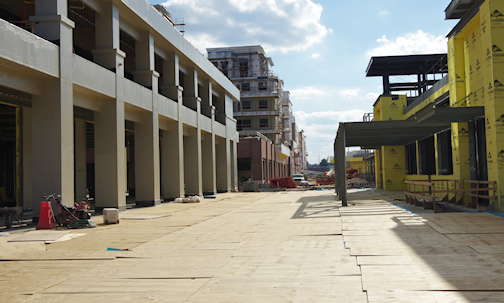
The ballpark is at the east end of the parcel of land because the Braves “wanted to maximize the density of the development, to create kind of a corridor from one end of the project to the other, with the ballpark being that end point on that access through the development,” Albers explained. This shot was taken with the ballpark to my back, looking west down the “corridor” with restaurants, shops, offices and — in the distance — apartments and condos.
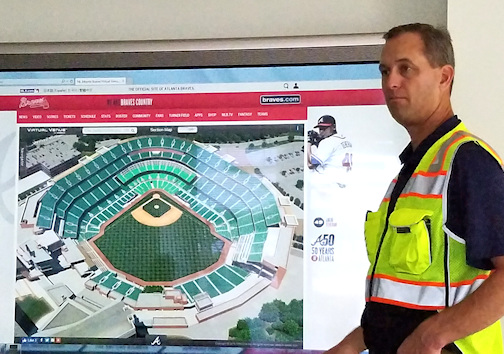
Many thanks to Derek Schiller, shown above in the Preview Center, and Beth Marshall (shown below with me) for the exceptional tour. Folks, this is one incredible project, and the thinking behind it is truly impressive.
